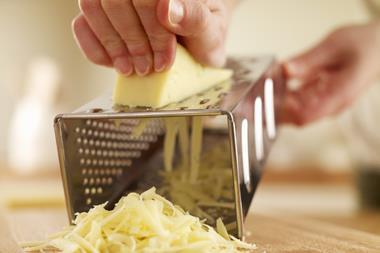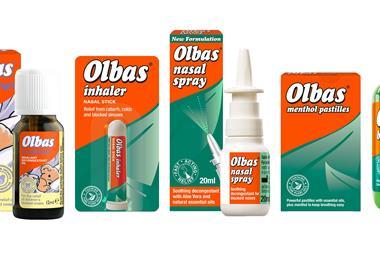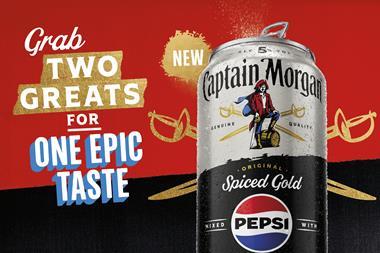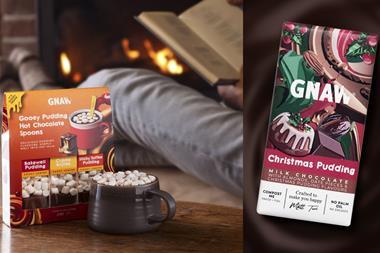With shoppers increasingly looking to eat more healthily, sales of fresh seafood are continuing to grow. And in convenience stores, the story is even more impressive, with sales growing by 52% last year and by 131% in the past two years, compared with 10% year on year in the total grocery market, according to AC Nielsen data.
Yvonne Adam, business development controller (chilled) at Young's Seafood, says that technology has made the seafood market more accessible to c-stores. "The good news for the convenience sector is that advances in technology are generating longer shelf life, which should provide greater confidence to stock a stronger seafood range.
"Retailers should stock a core range of extended-life seafood - available throughout the week and merchandised together in the chilled cabinet," she says. "By boosting the visibility of fish you help consumers get used to the idea that fish is a reliable, regular choice from their local shop, and sales will grow."
As well as introducing longer shelf lives, suppliers have been making it easier for
c-stores to enter the category by creating pack formats suited to the sector. Young's has just extended its range of 10-day shelf-life products with three ready-to-eat prawn varieties: wild caught Greenland prawns; Caribbean king prawns; and tropical tiger prawns. The Greenland variety comes in a 150g pack with a rrp of £1.99, and the latter retails at £2.99 for 125g packs.
The range extension follows the launch of four ready meals in July and four twin-packed coated fish products in June. The ready meals range comprises Famous Fisherman's Pie; Haddock Mornay; Tuna & Penne Pasta; and Eastern curry King Prawn Makhani (rrp for each meal ranges from £1.99 to £2.99). The twin-packed coated fish with a shelf life of at least 10 days includes: breaded cod fillets; breaded haddock fillets; salmon fishcakes; cod fishcakes; and cod with chips. Retail prices range from £1.49 to £2.99.
Other key launches this year have come from the Big Prawn Company with its Breakers seafood snacking range. The range comprises four seafood and sauce products: tiger prawns with a sweet chilli dip; coldwater prawns with seafood sauce; crayfish tails with a chilli & lime mayo; and mussels with a tomato & basil sauce. Each is packaged in 120g tubs containing separate seafood and sauce. The products have a shelf life of seven days and retail at £1.99-£2.99.
According to Young's Adam, the best-selling seafood products in c-stores include seafood sticks, ready-to-eat mackerel, 100g packs of smoked salmon, chilled prawns and fisherman's pie. "We also recommend retailers put in at least one strong promotional offer on chilled fish every two weeks," she says. "This boosts interest on shelf, reminds people of the variety available and encourages trial."
Despite such strong growth in fresh fish, many retailers are still put off by the inevitable wastage. "We advise our c-store customers to expect higher wastage initially, but this is a developing category so retailers should appreciate its longer-term potential," says Adam. "Be brave, stick with it, and by maintaining a consistent core offer wastage levels of below 1% should be possible. And 10 days' shelf life should ultimately deliver the optimum balance between low percentage waste and highest in-store stock - effectively making chilled fish perform more like an ambient supply chain."
Musgrave Budgens Londis is so convinced by the seafood category that it is relaunching its fresh fish offer, initially within Budgens stores, on September 14. MBL head of fresh food buying Steve Carter says: "Until now we have only been in branded products, but we are bringing fresh fish back into own label to create consistency across the range and give it the exposure it deserves."
As with all of its fresh food categories, MBL has created a 'Good, Better, Best' offer, along with a premium branded specialist range, so that all tastes and budgets are catered for. The basic 'Good' range will include everyday items such as breaded white fish and Scottish salmon steaks. 'Better' will include fillets, oily and smoked fish and fishcakes, and 'Best' will be own-label premium fish such as Alaskan wild salmon, fresh scallops and tuna.
Carter adds: "As a major element of the relaunch we will be offering a permanent multibuy in the entry point range," he says.
lasting appeal
While the growth in seafood is set to continue, Adam says that one issue that could affect the category is sustainability. "It's vital to tackle consumer concerns that seafood is an ethical choice and one that's available for the long term," she says. "This is partly addressed by broadening the range of available species, reducing the pressure on traditional white fish. But we are also working hard to add Marine Stewardship Council-accredited alternatives such as Pacific cod and Alaskan pollock."
"We will continue to deliver more variety and a wider range of species into our products. Another key driver is health, so we will introduce more products made using oily fish rich in Omega 3.
"There is no indication that the demand for fish will reduce. As consumers get used to the wider availability of fresh fish, c-store retailers should increase the space they dedicate to seafood."
Retailer: Carol Millington, manager, The Village Shop, Litton, Derbyshire
Fresh strategy: The Village Shop is a magnet for the elderly population who do their weekly shop there - or rather staff do the shopping for them and they subsequently collect it or have it delivered. For the majority of locals the shop is a buffer to top up their weekly trip to the supermarket.
As a community-owned shop, run largely by volunteers, it stocks a basic range of pretty much everything, and sourcing products locally is a priority. Most products are sourced from Somerfield in Matlock, although fresh meats including ham, sausages and bacon come from local butcher Hancocks, in nearby Stoney Middleton.
Carol says: "Somerfield has been hugely supportive and we get quality produce from it, but in order to service customers we do buy a lot of extra products such as fresh meat and produce from local suppliers."
The fresh produce range from Somerfield includes apples, oranges, green vegetables and carrots, is bolstered by extras from a local greengrocer plus a village pensioner who grows his own vegetables. "He grows a range of vegetables, including lettuce and dwarf beans, but it's his watercress and cucumbers that are in particular demand. It is important to sell quality fresh produce, even though it's only a small part of the business.
"Best-sellers within chilled include ham, bacon, pâté, yogurt, milk, Elmlea cream, Flora, Clover, these sorts of things. We don't have any healthy yogurt drinks because there's no demand, but we are considering investing in a larger chiller unit
given the rate at which chilled products sell. There is definitely room for expansion."
Parsnips
Parsnips are a root vegetable related to carrots and resemble a top-heavy, ivory coloured carrot, but with a mild celery-like fragrance and a sweet, nutty flavour. Unlike carrots, parsnips contain no beta carotene but they are a good source of vitamin C. Their flavour is best in winter when they are most abundant.
Planted in the spring, parsnips take a full three to four months to mature. They are left in the ground until a hard frost occurs in late autumn that initiates the conversion of the starches in the vegetable to sugars, giving parsnips their sweet flavour.
Parsnips range in colour from pale yellow to off white, and although they can grow up to 20 inches long, they are most tender when about eight inches. Look for small, firm, and well-shaped roots (very large parsnips may be woody), and avoid those that are limp, shrivelled, or spotted.
Irregularly shaped parsnips are considered wasteful because they require extensive trimming for cooking. Parsnips with moist spots should also be avoided. Most parsnips are sold "clip-topped," but if the leafy tops are still attached, they should look fresh and green.
If the green tops, or parts of them, are attached, remove before storing, or they will draw moisture from the roots.
Like carrots, parsnips keep best in a perforated plastic bag in the refrigerator. They can last for up to three to four weeks.
Yvonne Adam, business development controller (chilled) at Young's Seafood, says that technology has made the seafood market more accessible to c-stores. "The good news for the convenience sector is that advances in technology are generating longer shelf life, which should provide greater confidence to stock a stronger seafood range.
"Retailers should stock a core range of extended-life seafood - available throughout the week and merchandised together in the chilled cabinet," she says. "By boosting the visibility of fish you help consumers get used to the idea that fish is a reliable, regular choice from their local shop, and sales will grow."
As well as introducing longer shelf lives, suppliers have been making it easier for
c-stores to enter the category by creating pack formats suited to the sector. Young's has just extended its range of 10-day shelf-life products with three ready-to-eat prawn varieties: wild caught Greenland prawns; Caribbean king prawns; and tropical tiger prawns. The Greenland variety comes in a 150g pack with a rrp of £1.99, and the latter retails at £2.99 for 125g packs.
The range extension follows the launch of four ready meals in July and four twin-packed coated fish products in June. The ready meals range comprises Famous Fisherman's Pie; Haddock Mornay; Tuna & Penne Pasta; and Eastern curry King Prawn Makhani (rrp for each meal ranges from £1.99 to £2.99). The twin-packed coated fish with a shelf life of at least 10 days includes: breaded cod fillets; breaded haddock fillets; salmon fishcakes; cod fishcakes; and cod with chips. Retail prices range from £1.49 to £2.99.
Other key launches this year have come from the Big Prawn Company with its Breakers seafood snacking range. The range comprises four seafood and sauce products: tiger prawns with a sweet chilli dip; coldwater prawns with seafood sauce; crayfish tails with a chilli & lime mayo; and mussels with a tomato & basil sauce. Each is packaged in 120g tubs containing separate seafood and sauce. The products have a shelf life of seven days and retail at £1.99-£2.99.
According to Young's Adam, the best-selling seafood products in c-stores include seafood sticks, ready-to-eat mackerel, 100g packs of smoked salmon, chilled prawns and fisherman's pie. "We also recommend retailers put in at least one strong promotional offer on chilled fish every two weeks," she says. "This boosts interest on shelf, reminds people of the variety available and encourages trial."
Despite such strong growth in fresh fish, many retailers are still put off by the inevitable wastage. "We advise our c-store customers to expect higher wastage initially, but this is a developing category so retailers should appreciate its longer-term potential," says Adam. "Be brave, stick with it, and by maintaining a consistent core offer wastage levels of below 1% should be possible. And 10 days' shelf life should ultimately deliver the optimum balance between low percentage waste and highest in-store stock - effectively making chilled fish perform more like an ambient supply chain."
Musgrave Budgens Londis is so convinced by the seafood category that it is relaunching its fresh fish offer, initially within Budgens stores, on September 14. MBL head of fresh food buying Steve Carter says: "Until now we have only been in branded products, but we are bringing fresh fish back into own label to create consistency across the range and give it the exposure it deserves."
As with all of its fresh food categories, MBL has created a 'Good, Better, Best' offer, along with a premium branded specialist range, so that all tastes and budgets are catered for. The basic 'Good' range will include everyday items such as breaded white fish and Scottish salmon steaks. 'Better' will include fillets, oily and smoked fish and fishcakes, and 'Best' will be own-label premium fish such as Alaskan wild salmon, fresh scallops and tuna.
Carter adds: "As a major element of the relaunch we will be offering a permanent multibuy in the entry point range," he says.
lasting appeal
While the growth in seafood is set to continue, Adam says that one issue that could affect the category is sustainability. "It's vital to tackle consumer concerns that seafood is an ethical choice and one that's available for the long term," she says. "This is partly addressed by broadening the range of available species, reducing the pressure on traditional white fish. But we are also working hard to add Marine Stewardship Council-accredited alternatives such as Pacific cod and Alaskan pollock."
"We will continue to deliver more variety and a wider range of species into our products. Another key driver is health, so we will introduce more products made using oily fish rich in Omega 3.
"There is no indication that the demand for fish will reduce. As consumers get used to the wider availability of fresh fish, c-store retailers should increase the space they dedicate to seafood."
talk back
Retailer: Carol Millington, manager, The Village Shop, Litton, Derbyshire
Fresh strategy: The Village Shop is a magnet for the elderly population who do their weekly shop there - or rather staff do the shopping for them and they subsequently collect it or have it delivered. For the majority of locals the shop is a buffer to top up their weekly trip to the supermarket.
As a community-owned shop, run largely by volunteers, it stocks a basic range of pretty much everything, and sourcing products locally is a priority. Most products are sourced from Somerfield in Matlock, although fresh meats including ham, sausages and bacon come from local butcher Hancocks, in nearby Stoney Middleton.
Carol says: "Somerfield has been hugely supportive and we get quality produce from it, but in order to service customers we do buy a lot of extra products such as fresh meat and produce from local suppliers."
The fresh produce range from Somerfield includes apples, oranges, green vegetables and carrots, is bolstered by extras from a local greengrocer plus a village pensioner who grows his own vegetables. "He grows a range of vegetables, including lettuce and dwarf beans, but it's his watercress and cucumbers that are in particular demand. It is important to sell quality fresh produce, even though it's only a small part of the business.
"Best-sellers within chilled include ham, bacon, pâté, yogurt, milk, Elmlea cream, Flora, Clover, these sorts of things. We don't have any healthy yogurt drinks because there's no demand, but we are considering investing in a larger chiller unit
given the rate at which chilled products sell. There is definitely room for expansion."
spotlight
Parsnips
Parsnips are a root vegetable related to carrots and resemble a top-heavy, ivory coloured carrot, but with a mild celery-like fragrance and a sweet, nutty flavour. Unlike carrots, parsnips contain no beta carotene but they are a good source of vitamin C. Their flavour is best in winter when they are most abundant.
Planted in the spring, parsnips take a full three to four months to mature. They are left in the ground until a hard frost occurs in late autumn that initiates the conversion of the starches in the vegetable to sugars, giving parsnips their sweet flavour.
Parsnips range in colour from pale yellow to off white, and although they can grow up to 20 inches long, they are most tender when about eight inches. Look for small, firm, and well-shaped roots (very large parsnips may be woody), and avoid those that are limp, shrivelled, or spotted.
Irregularly shaped parsnips are considered wasteful because they require extensive trimming for cooking. Parsnips with moist spots should also be avoided. Most parsnips are sold "clip-topped," but if the leafy tops are still attached, they should look fresh and green.
If the green tops, or parts of them, are attached, remove before storing, or they will draw moisture from the roots.
Like carrots, parsnips keep best in a perforated plastic bag in the refrigerator. They can last for up to three to four weeks.



























No comments yet